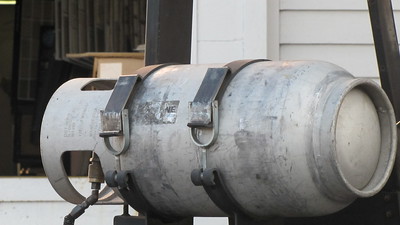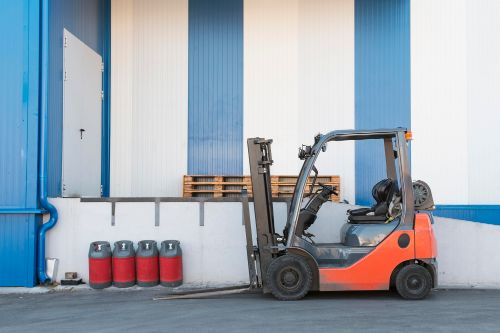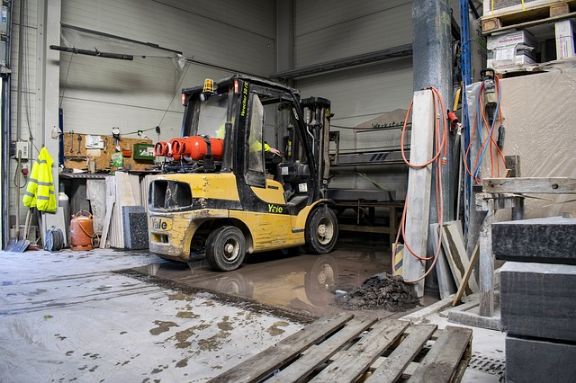
If you use a propane-powered forklift, it’s important to know when the tank is expired. An expired propane tank can be dangerous, and it can also lead to your forklift not working properly. Here are a few things to look for to see if your propane tank is expired:
Understanding Propane Tank Expiration
A. What Does “Expiration” Mean for Your Propane Tank?
Think of your forklift’s propane tank like a car seat for a child. It doesn’t spoil like food, but it does have a “best by” date for safety. When we talk about your propane tank expiring, we mean it’s reached the end of its safe life. Just like you wouldn’t want to risk using an old car seat, you shouldn’t risk using an out-of-date propane tank.
B. Tank vs. Fuel: What’s the Difference When It Comes to Expiration?
Your propane fuel is a worry-free buddy. It doesn’t care about time; it can sit in the tank without going bad. But the tank itself is a different story. It’s built to last a while, sure, but not forever. Over time, it can get worn out or damaged. So even though the fuel inside is fine, the tank holding it needs to retire at some point.
C. Who Says When It’s Time to Say Goodbye to Your Tank?
There are safety bosses for everything, and for propane tanks, it’s no different. In the U.S., organizations like the Department of Transportation (DOT) and the Occupational Safety and Health Administration (OSHA) set strict rules. They’re the ones who say, “Okay, this tank’s good for 12 years,” and they decide when it’s time for a check-up or a replacement. These check-ups need to happen every 5 to 10 years after those first 12 years are up. And it’s not just a suggestion – it’s the law. If you don’t follow these rules, it’s not just unsafe, it could also get you in trouble.
Read related article: Forklift Propane MSDS: What Does the Document Contain?
Checking the expiration date on your forklift propane tank
A. Finding the Manufacturing Date on Your Propane Tank
Look around your propane tank. You’ll find a bunch of numbers stamped on it. One of these is the date it was made. You’re looking for something that looks like a month and a year – it might be alone or part of a longer code. This is the manufacturing date, and it’s the starting point for figuring out how long your tank is good for.
B. Figuring Out When Your Tank Expires
Got the manufacturing date? Great! Now add 12 years to that. That’s how long the Department of Transportation (DOT) says your tank can be used before it needs to be checked out. After the first 12 years, if it passes inspection, it gets another stamp, and you’ll add either 5 or 10 more years to that new date, depending on what the inspector says.
C. How Long Do Forklift Propane Tanks Usually Last?
On average, a forklift propane tank is set to live a good, safe 12 years from the date it was born – I mean, made. After that, if it gets the green light from the inspector, it can have more time – up to 5 or 10 extra years. Remember, these numbers aren’t just guesses. They’re the rules to make sure you and everyone at work stay safe.
Read related article: What Size Propane Tank Does a Forklift Take?
Visual Inspection Cues
A. Spotting Wear and Tear on Your Propane Tank
When you’re checking out your forklift’s propane tank, you’re playing detective. Look for clues like scratches, dings, and areas where the metal seems to be eaten away. These are signs of wear and corrosion. If your tank is looking rough, with bits of metal flaking off or parts that seem thinner than they should be, it’s telling you that it’s not as strong as it used to be.
B. Why Rust, Dents, and the Valve Matter
Think of rust and dents as red flags on your tank. Rust can make the metal brittle and weak, and dents can mean the tank’s been hit or dropped, which can mess with its strength. And the valve? That’s like the door to the fuel inside. If it’s not in good shape—say it’s hard to turn or it’s leaking—you’ve got a problem. These things can make your tank unsafe.
C. Decoding the Colors on Your Propane Tank
The color of your propane tank isn’t just about looking good. It’s practical, too. Dark colors can soak up heat, which makes the pressure inside the tank go up—risky business for sure. That’s why you’ll often see propane tanks in lighter colors, like white, silver, or yellow, which reflect the sun and keep things cooler. If your tank’s paint is flaking off or it’s been painted a dark color, it’s time to give it some TLC and possibly a new coat of paint in a lighter, heat-reflective color.
Read related article: Forklift Propane Tank Lifespan (When to Replace It)
Understanding Requalification and Recertification
A. The Process of Tank Requalification
Think of requalification as your propane tank’s check-up. It’s a detailed examination that must be done by experts who’ve been given the thumbs-up by the Department of Transportation (DOT). They’re like doctors for your tank. They’ll check the tank’s health—looking for dents, rust, or other signs of trouble. They’ll also do tests to make sure the tank is still tough enough to handle the pressure of the propane. If it passes, it gets a new lease on life, along with a new date stamp to prove it’s still fit for use.
B. How Recertification Gives Your Tank More Time
Recertification is the green light that your tank is good to go for another stretch. It’s like renewing your tank’s driver’s license. When a tank is recertified, it means it’s still safe to use—it hasn’t gotten too weak or damaged. This can extend your tank’s usable life, so you don’t have to buy a new one right away. It’s good for your safety and your wallet.
C. The Timeline for Giving Your Tank a Check-Up
Your tank’s first check-up is due 12 years after it was made. After that, it’s like a car needing regular oil changes—it needs to be checked every 5 or 10 years. The exact time depends on what the experts find and what methods they use to test it. Mark your calendar or set a reminder because staying on top of these dates is super important for keeping things safe and up to code.
Legal and Compliance Considerations
A. Following the Rules from OSHA and Other Regulators
When it comes to propane tanks on your forklifts, the Occupational Safety and Health Administration (OSHA) and other groups have a say. They make the rules to keep everyone safe. These rules cover how tanks should be made, when they need to be checked, and how they should be used. It’s your job to know these rules and play by them.
B. What Happens if You Use a Tank Past Its Time
Using a propane tank that’s too old is like driving with an expired license. If something goes wrong, you could be in big trouble. You might face fines, your insurance might not cover damages, and worst of all, you could put people at risk. It’s just not worth the gamble.
C. Keeping Track of Tank History
Just like you keep receipts for important purchases, you need to keep records of your tank’s inspections and the dates when it’s been given the okay to use. These records can show inspectors, and anyone else who needs to know, that you’re doing things right.
Safety Measures and Best Practices
A. The Importance of Regular Tank Check-Ups
Routine checks on your propane tanks are like regular health check-ups; they catch problems before they become serious. These inspections help make sure that the tanks are safe and ready to work.
B. Training the People Who Use the Tanks
Everyone who works with or around your forklifts needs to know the drill. This includes how to handle propane tanks safely, what to look out for, and what the rules are. Proper training can prevent accidents and keep everyone safe.
C. What to Do with Out-of-Date Tanks
If you find a tank that’s past its prime, you’ve got to take it out of service—no ifs, ands, or buts. You’ll need to have a plan in place for how to deal with these tanks safely until they can be requalified or disposed of.
Replacing Your Forklift Propane Tank
A. When It’s Time for a New Tank
Once your tank is officially retired, you’ll need a replacement. You can buy a new one or lease it, depending on what makes sense for your business.
B. Getting Rid of the Old Tank
Don’t just toss your old tank in the dumpster. There are rules for how to get rid of it safely and responsibly. Usually, this means taking it to a spot that can handle tanks that are out of date or no longer safe.
C. Picking the Right Tank and Seller
When you’re in the market for a new tank, you want to make sure you’re getting it from someone reliable. Look at the tank’s quality, check if the seller knows their stuff, and make sure the tank meets all the safety standards. It’s not just about the price—it’s about keeping your workplace safe.
Reducing the risk of using an expired forklift propane tank
If your forklift’s propane tank is expired, there are a few things you can do to reduce the risk of using it. First, check the date on the tank. If it is more than 12 years old, it is probably expired. Second, look for any physical signs of damage, such as dents, cracks, or leaks. If you see any of these, do not use the tank. Third, have the tank inspected by a certified professional. They will be able to tell you if the tank is safe to use. Finally, if you are unsure about the tank, do not use it. It is better to be safe than sorry.
What to do if your forklift propane tank is expired
If you discover that your forklift’s propane tank is expired, it’s essential to address the situation promptly to ensure safety and compliance with regulations. Here’s what to do:
1. Remove the Tank from Service: Immediately cease using the expired tank. Do not attempt to refill or use it until it has been properly requalified or replaced.
2. Check for Requalification Eligibility: Look at the tank’s most recent requalification date to see if it is eligible for requalification. Propane tanks are often eligible for requalification up to 12 years from the manufacture date and every 5 to 10 years thereafter.
3. Arrange for Requalification: If the tank is eligible for requalification, contact a licensed professional to perform the requalification process. The technician will inspect the tank for damage, test its integrity, and apply a new certification mark if it passes the inspection.
4. Replace the Tank: If the tank is not eligible for requalification or fails the requalification process, it will need to be replaced. Purchase or lease a new tank from a reputable supplier who can provide documentation of the tank’s compliance and certification.
5. Proper Disposal: Expired tanks that cannot be requalified should be disposed of according to local regulations. Do not attempt to dispose of the tank in general waste. Contact local waste management services or the tank’s supplier for disposal instructions.
6. Update Records: Maintain up-to-date records of all your propane tanks’ statuses, including the requalification dates, any maintenance performed, and the disposal of old tanks. These records are essential for regulatory compliance and safety audits.
7. Train Employees: Make sure that all employees who handle forklift propane tanks are trained on how to identify an expired tank and understand the proper procedures for dealing with one. Regular training and refreshers can prevent the use of expired tanks.
8. Implement Regular Inspections: To prevent future issues, set up a regular inspection schedule for all propane tanks and make sure that someone is responsible for monitoring expiration dates. This proactive approach will ensure that all tanks are in compliance and safe to use.
By following these steps, you can ensure that your expired forklift propane tank is managed safely and in accordance with legal requirements, keeping your workplace safe and operational.
Purchasing a new or used forklift propane tank
If your forklift propane tank is expired, you will need to purchase a new one. The process of purchasing a new or used forklift propane tank is relatively simple. However, there are a few things you should keep in mind to ensure that you get the best possible deal.
First, you should decide whether you want a new or used forklift propane tank. If you choose to purchase a new tank, you will likely pay more upfront. However, you can be sure that the tank is in good condition and will not need to be replaced for some time. If you choose to purchase a used tank, you may be able to get a good deal. However, you will want to inspect the tank carefully to ensure that it is in good condition.
Next, you will need to find a reputable supplier of forklift propane tanks. You can ask around at your local warehouse or industrial area for recommendations. You can also search online for suppliers. Once you have found a few potential suppliers, you will need to compare prices and services.
Finally, you will need to make a decision on which supplier to use. Once you have made your decision, you can contact the supplier and arrange for the delivery of your new forklift propane tank.
Maintaining a forklift propane tank
When a forklift’s propane tank expires, it’s important to know how to properly maintain it. Here are a few tips on how to tell if your tank is expired:
- Check the date stamped on the tank. This is the date that the tank was manufactured, and it’s generally good for about 10 years.
- Inspect the tank for any signs of rust or corrosion. This can weaken the tank and cause it to fail.
- Check the pressure gauge to see if the pressure is at the proper level. If it’s too low, it could be a sign that the tank is expired.
- Have the tank professionally inspected every few years. This will ensure that it’s in good condition and that there are no hidden issues.
If you suspect that your propane tank is expired, it’s important to have it replaced as soon as possible. A failing tank could cause a fire or explosion, which could be very dangerous.
Read related article: How Does a Forklift Propane Regulator Work?
Inspecting a forklift propane tank
It’s important to inspect your forklift propane tank on a regular basis to ensure it is in good condition and has not expired. An expired tank can pose a serious safety hazard. Here are some things to look for when inspecting a propane tank:
- The date of manufacture. This is usually stamped on the tank. Propane tanks have a 12-year life span, so if the tank is more than 12 years old, it needs to be replaced.
- The condition of the tank. Look for any dents, rust, or other damage. A damaged tank needs to be replaced.
- The level of propane in the tank. If the tank is less than 20% full, it needs to be refilled.
- The pressure in the tank. Check the pressure gauge to make sure the tank is at the proper pressure. If the pressure is too low, the tank needs to be refilled.
If you have any doubts about the condition of your propane tank, it’s best to replace it. It’s not worth taking the risk of using an expired or damaged tank.
Conclusion
Remember, keeping an eye on when your propane tank says “goodbye” isn’t just busywork. It’s a key part of making sure your forklift and workplace stay safe. Those expiration dates are there to remind you that time, wear, and tear take their toll on even the sturdiest tanks.
Let’s keep it simple: Stick to the rules, train your people, and don’t cut corners with your propane tanks. Staying on top of inspections and certifications isn’t just following the law—it’s smart, and it’s safe. It protects your team, your gear, and you.
At the end of the day, it’s all about maintaining a space where everyone can work without worry. By managing your propane tanks well—understanding their lifespan, staying up to date on inspections, and knowing when to say goodbye—you’re doing just that. A safe work environment is a productive one, so take pride in keeping yours in tip-top shape.

Mike is an experienced propane technician with over 15 years of professional experience in the field. He has dedicated his career to helping customers with their propane needs, from installation to maintenance and repair. Together with Jeremy, he co-founded this website to provide useful information and guidance to customers seeking reliable propane services.



